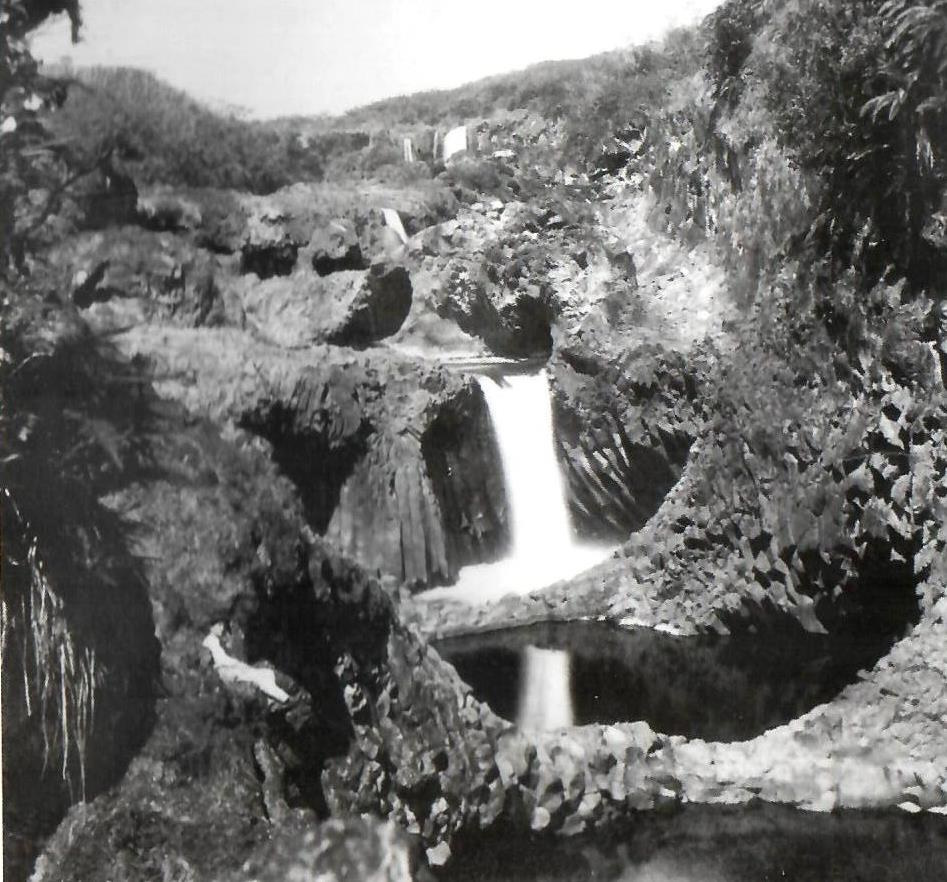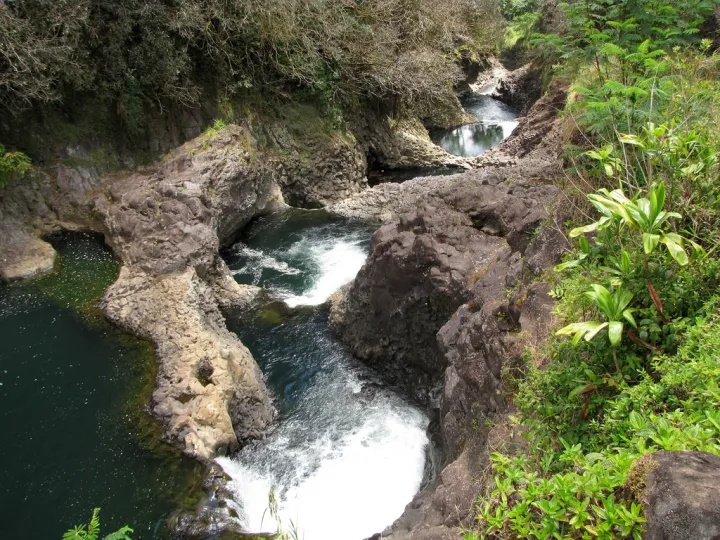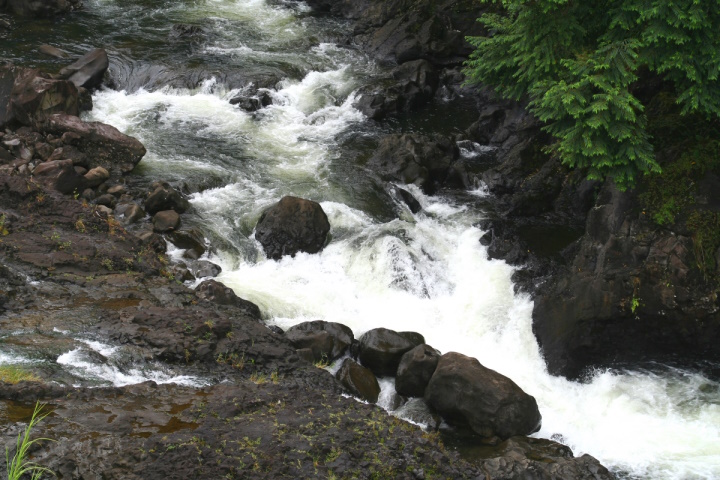“The Hawaiian Group consists of five principal islands, viz: Hawaii, Maui, Oahu, Molokai and Kauai, upon which the main portion of the inhabitants reside, and where the principal industries are carried on; three minor islands, viz. Lanai, Kahoolawe and Niihau, where the population is very sparse, and three barren rocks, viz. Molokini, Lehua and Kaula.”
“There are three principal ports at which the voyager may land, viz: Honolulu on Oahu, Kahului on Maui, and Hilo on Hawaii. All these have direct communication with San Francisco, but only the first has steam communication. The latter ports can at present be reached by sailing vessels.” (Whitney, Tourist Guide, 1890)
“There is also a fleet of steam and sailing vessels in the InterIsland, South Sea and Pacific Coast trade belonging to Honolulu. The principal local organizations are the Wilder Steamship Company and the Inter-Island Steam Navigation Company.” (Whitney, Tourist Guide, 1890)
By the 1930s, “Vessels of three steamship lines make Hilo on the island of Hawaii a regular port of call. The Inter-Island Steam Navigation Go. Operates modern steamers between Honolulu and Hilo twice each week. Certain ships of the Matson Navigation Co., after stopping at Honolulu, continue on to Hilo and furnish a part-daylight trip among the islands. …”
“The vessels of the Nippon Yusen Kaisha South America West Coast Line stop at Hilo 1 day after leaving Honolulu, en route from the Orient to South America via San Francisco, service approximately every 5 weeks.”
The sugar companies began clearing the fertile lowlands of Hāmākua in the mid to late-1800s to make way for the expansion of sugarcane production on the island of Hawai‘i. (Peralto)
“The entire coast line, excepting where the big gulches break through is sheer cliff of varying height up to 400 ft and behind the land, which is cut by frequent gulches, rises with gentle even slope to the mountain: every available bit of land, from the actual cliff edge to the timber line, is cane covered.”
“A fringe of evergreens will be seen along cliff edge in places. These were planted to protect the cane from the NE trade. No off lying dangers were found in the steamer track: they generally pass close in. The landings however should be approached with caution”. (Coast and Geodetic Survey, 1913)
“At one time there were 26 sugar plantations along the [Hamakua Coast]”. (LA Times) “Over the Big Island, with Hawaiian Air Lines – ‘You’re now flying over the Hamakua coast … said our purser. Below us is the most productive soil in the world. As much as 300,000 pounds of sugar cane have been grown per acre on these plantations.’”
“He could have added that from an 18-mile square area, slightly larger than that of New York City, Hawaii produces over a 1,000,000 tons of sugar, manufactured in the US,’ pointed out my fellow passenger, Roy Leffingwell, of the Hawaii Sugar Plantations association. ‘It’s Hawaii’s main industry ….’” (Burns; Medford Mail Tribune)
In the district of Hāmākua “come sugar plantations, mills and scattered houses. For nearly sixty miles there is one continuous ribbon of cane and a succession of mills until Hilo is reached.”
“The Hilo coast, which commences four miles before reaching Laupahoehoe, is abrupt and pierced by numerous gulches, large and small. There are said to be sixty-two from Laupahoehoe to Hilo. Down each of these winds a stream, ending, in most cases, in a waterfall that leaps into the sea. These slender silver threads seem to be countless.” (Whitney, Tourist Guide, 1890)
“The coast of Hawaii known as the Hamakua Coast was a stretch of about 50 miles running north from Hilo to {Kukuihaele]. The shore was a continuous bluff from 100 to 400 feet above sea level.”
“All the plantations were on the top of the bluff, and the reason for the wire landings was that the shore line was so rough and dangerous for boat work most of the time that some means had to be found to enable the loading to be carried on in all kinds of weather.”
“The idea of loading by wire was imported from the Pacific Coast when lumber from the redwood forests had been shipped that way for many years. As the trade winds blow almost constantly from the east north east all the landings and moorings were laid out so that the steamer would lay head to the wind and sea.”
“In coming to a wire landing, the steamer was taken in between the two head buoys and one or two anchors let go and enough chain payed out to allow the ship to turn around head to the wind, with the small ‘wire buoy’ alongside the off shore side of the ship near the fore hatch.”
“When all was connected up and ready the work began. If we had cargo, that was first hoisted up out of the hold and landed on deck or on the half of the hatch cover that was always left on for the crew to stand on. “
“After all the cargo was ashore, the process was reversed and the [bagged] sugar was sent down on the carriage and landed on the ship’s hatch and then tumbled down for the rest of the crew to stow away in the hold. [The Sugar was taken] in from those plantations and delivered it to the ships to take to San Francisco.” ((Nelson) Frazier)
North to south, here are some brief descriptions of the landings where the steamers stop to deliver goods and transport sugar in 1909: Kukuihaele, Honoka‘a; Pa‘auhau; Koholālele; Kuka‘iau; O‘okala (Kaiwiki); Laupāhoehoe; Papa‘aloa; Hakalau; Honomu; Pepe‘ekeo; Pāpa’ikou and Wainaku.
Kukuihaele Landing “Consists of a fifteen-ton derrick at the foot of a bluff, connected with the warehouse at the top of the bluff at about 100 feet elevation, with an inclined cable railway about 200 feet in length. From this warehouse runs an inclined cable railway to the mill. distance of about 2,300 feet, thence to a warehouse on the government road about 6,000 feet distant from landing.”
“Volume of freight is a maximum of 7,000 tons outgoing sugar and about the same quantity of incoming merchandise. Passengers and mail occasionally land here”. “[F]reight is hauled from the landing on cars by means of cable to the warehouse upon the government road – elevation 800 feet, in three stages, viz …”
“… first, from landing to landing warehouse, transferred upon other cars; second, to mill power house; third, then reattached to three thousand seven hundred feet cable to warehouse; a total distance of about six thousand feet, which necessitates the handling of freight no less than three times.”
Honoka‘a Landing has “a fifteen-ton derrick on a masonry pier on a rock bluff, operated either by steam furnished from boiler at landing, or by compressed air from the mill. An incline cable railway from the derrick to the mill, three-quarters of a mile long, is operated either by steam, or by a ninety horsepower gasoline engine, which also operates the air compressor when the mill is shut down.”
“There is also a further incline cable railway leading up to the Government belt road, at an elevation above 1,000 feet, where the plantation maintains a warehouse and a freight clerk. … There are about 12,000 tons of sugar and a small amount of other freight outgoing annually and about 12,000 tons of incoming merchandise and lumber.”
“There is an average of six steamers per month, all being tramp steamers, but one, which call regularly once a week. These vessels run to and from Honolulu.”
Pa‘auhau Landing has “a twenty-ton derrick for heavy machinery connected with the warehouse on the top of the cliff by an incline cable railway built on very heavy masonry foundation, also a wire rope landing running into another large warehouse on top of the cliff. The wire rope equipment is very heavy and the cable is 700 feet Jong.”
“The plantation railway system runs into and alongside warehouses. There is a roadway leading to the warehouse ; this road is considered private, at least in part, but always open to the public during plantation business hours.”
“Volume of freight 10,500 tons of sugar and some 600 to 3000 bags of coffee outgoing annually-probably about the same amount of incoming freight. … About 8 to 10 steamers call here every month. This is the only landing in Hamakua district having regular steamer connection with Hilo, the sugar going to Hilo for across ocean shipment.”
Koholālele Landing “is about 2 miles from the plantation headquarters [Hamakua Mill] and about 3 miles from the Paauilo village. There is a fifteen-ton derrick sixteen feet above sea level operated by steam, also an incline cable railway 800 feet long to the main warehouse, into which the tracks of the plantation railway run.”
“There is a very good anchorage at this landing, protected by a point of rock, and it is said that this landing can be worked when Honokaa, Kukuihaele and Paauhau are impossible.”
“Volume of freight about 10,000 tons of sugar per annum, and very little outgoing freight from outsiders; mostly small packages for which no charge is made. The incoming freight is estimated at 5,000 tons per annum.”
“There is an average of one steamer a week calling here, with no regular dates, most steamers being bound to or from Honolulu and way ports, the sugar going to Honolulu.”
Kuka‘iau Landing “consists of a twenty-ton derrick on a staging 20 feet above water at the foot of the bluff, and an incline cable railway to a second landing 195 feet above the sea. This incline cable railway is on a 52 degree uniform slope, and consists of double tracks with 2 cars or car elevators, the top of which are tracked, connected by cable-one going up while the other goes down; the derrick and cable railway being operated by steam.”
“About 1,500 to 2,000 tons of merchandise, and about 100,000 feet of lumber per year are handled over this landing besides the sugar output of Kukaiau. This landing is seldom used for mail or passengers …. About three Inter-Island steamers call at this landing each month at irregular intervals, the sugar being shipped to Honolulu.”
O‘okala (Kaiwiki) Landing “is a wire rope landing on top of a bluff about 395 feet above sea, using a wire cable 850 feet long. All heavy freight for Kaiwiki Sugar Company is handled at Laupahoehoe. … The plantation management reports that no outside freight is handled here except for Ookala store, run by a Japanese, and Sam Wo Jam’s store.”
Laupāhoehoe Landing … “Laupahoehoe is a singular place, standing on lava, which has been declared to be the last expiring effort of Maunakea, a strip running right to the sea, down the great rent in the coastline, which forms the Laupahoehoe Valley.”
“At Laupahoehoe the landing is very good and the lands rich. Messrs. Lidgate and Campbell have fine cane growing and every prospect of success in their enterprise at this place.” ((1877) Maly) “There is also an excellent landing at this plantation.” (Bowser, 1880; Maly) As noted in summaries of the surrounding Landings, Laupāhoehoe was the place of choice for ‘heavy’ freight.
“Laupahoehoe (leaf of lava) is an extensive village situated at the mouth of a deep gulch, on a flat stretch of land. It has the only landing used for passengers on this side of the island, outside of Hilo. … [however,] at times it is impossible to land.” (Kinney (1913))
Papa‘aloa Landing “is a wire rope landing, 182 feet above sea level, using a wire 925 feet long; also an incline cable railway connecting the wire rope landing with the plantation warehouse 330 feet distant and on about 30 feet higher ground. The railway is operated by a water wheel; the wire rope trolleys by steam.”
“There is very little outside business handled at this landing. The owners have no schedule of landing charges, but by special arrangements occasionally handle freight for outsiders …. Heavy pieces of plantation freights are handled through Laupahoehoe. Most steamers are to and from Honolulu where sugar is shipped.”
Hakalau Landing “consists of a wire cable 150 feet above the sea and an incline cable railway about 400 feet long running from wire landing warehouse to another warehouse and power house on public road. A derrick landing at the foot of the bluff is connected with the warehouse at the top of the bluff by a cable railway.”
“Practically nothing is landed here except for the plantation, and plantation employees. … Nearly all steamers touching here are to and from Hilo, to which point the sugar is shipped.”
Honomu Landing “consists of a derrick for handling heavy machinery at the foot of the bluff connected with an incline cable railway; also a wire landing for handling sugar and merchandise.”
“No outside freight is handled at this place, except by special arrangement and this is seldom because of the irregularity of steamer service-the outside freight of the sur rounding country being nearly all hauled overland from Hilo. About 11,000 tons of plantation freight, incoming 6.700 tons of sugar are passed over this landing per year, nearly all of which goes to or comes from Hilo.”
Pepe‘ekeo Landing “consists of a derrick for heavy machinery and a wire rope for handling plantation sugar and merchandise. About 12,000 tons of plantation freight pass over this landing per year. There is no regular steamer service as the shipping at this place depends on the loading or discharging of vessels lying in Hilo harbor.”
Pāpa’ikou Landing “consists of a derrick at boat landing for handling heavy freight; a wire cable system operated from tower on top of low bluff is used for handling sugar and plantation merchandise: very little outside freight is handled over this landing, and only by special arrangement.”
Wainaku Landing “consists of derrick for handling incoming freight and heavy pieces of outgoing freight, and chute from warehouse to lighter for handling sugar.”
“This landing is a little less than one mile distance from Hilo on the Hilo Bay. All freight to and from this landing, with the exception of occasional cargoes of lumber or heavy machinery by Inter-Island steamers, is handled by lighters from ships lying in Hilo harbor.”
(Most information here related to respective landings comes from a 1910 ‘Report of the Commission Appointed to Investigate Private Wharves and Landings.’)




















































